Introduction to Animal Behavior Why do they do

Introduction to Animal Behavior Why do they do that?

Warm Up l Personification: Putting human characteristics onto animals to explain behavior l Youtube: http: //www. youtube. com/watch? v=f. Kt_ku. YVt. U

Unit Map: Follow Along in your packet WHAT ARE YOU LEARNING? l Explain factors that serve to stimulate or discourage various types of animal behavior. l Recognize the normality curve of animal behavior.

Know Understand Do! Understand Know • Stimuli l Types of influence on Behavior behavior l History of • How ethology studying animal has evolved behavior Do • Observe and interpret animal behaviors • Evaluate animal studies

Key Learning: Animal Behavior l Unit EQ: How does animal behavior influence animal husbandry? Concept : Types Lesson EQ: What are categories of behavior? Vocab Stimuli, Behavior, Ethology Concept : History Concept : Influence Lesson EQ: How are animals studied for behavior? Vocab FAP, Skinner Box Lesson EQ: What can alter behavior ? Vocab Agnostic

What is Animal Behavior? The study of how and why animals interact with each other (both within and among species) and their environment. Proximate questions - how mechanisms responsible for interactions Ultimate questions - why how these interactions influence an individual's survival and reproduction.

Some examples: Intraspecific interactions mate choice male competition alarm calls parental care

Some examples: Interspecific interactions predation parasitism mutualism competition

Some examples: Interactions with the environment foraging nest site selection signal modification

Why study behavior? Possible first science: Our survival dependent on knowledge of other animals (prey/competitors/predators). Control/management of species: Food and game species, agricultural pests, invasive species, endangered species. Understanding/modification of our own behavior? Studies of how birds learn and develop songs provide unique insights into the development and neural control of speech in humans.

Curiosity. Science for science’s sake. Achieve a better understanding of the species we share the Earth with. Almost any behavior performed by animal may be interesting to study.

History of the study of animal behavior Paleolithic art from 40, 000+ years ago provide indirect evidence that primitive humans observed the behavior of animals. Cave paintings portray herding animals in groups, animal migration, certain predators hunting in packs, and solitary animals alone.

Blurton-Jones (1976) documented Kalahari bushmen’s (!Kung) knowledge of animal behavior Hunter-gatherer society, similar to most of human’s history. - Discriminated data from theory - Developed hypotheses - Used reasoned skepticism

Introduction l Why do animals do what they do? ¡ Why do birds sing? ¡ How do sea turtles navigate the ocean to lay their eggs on the same beach where they were hatched? ¡ How do honeybees know when the hive needs more food? Image from http: //www. nps. gov Image from http: //www. scottcamazine. com

Introduction l Animal behavior asks what, why, and how. l Animal behavior is also referred to as ethology. ¡ Scientists who study animal behavior are called ethologists. Image from http: //www. arcamax. com

Introduction l Animal behavior is centered around the ability to move. Image from http: //www. e-magine. education. tas. gov. au ¡Animals seek food, water, shelter. ¡Animals play with each other. ¡Animals seek mates.

Introduction l In order for an animal to move, it uses muscles. l So, in a way, we can think of animal behavior as being dependent on muscle movement. Image from http: //www. wildaboutcats. org

Introduction l Behavior results as a reaction to a stimulus. ¡A stimulus is a detectable change in the animal’s internal or external environment. ¡Hunger. ¡Sound. ¡Pain. ¡Visual cues. ¡Hormonal changes. Image from http: //www 3. nau. edu/biology/

What is really happening… l Lets watch! l As we watch, when the video pauses explain WHAT the animal is doing and WHY you think the animal is doing this l youtube. : http: //www. youtube. com/watch? v=LU 8 DD Yz 68 k. M

Introduction l Ethologists do not attempt to describe WHY an animal does a behavior before describing WHAT the animal is doing. ¡This removes as much bias as possible – good scientists don’t want to just “see what they want to see”. ¡Need to make objective observations of animal behaviors, analyze the data statistically, then come to conclusions about WHY an animal behaves a certain way.

Introduction l For example, you see two gophers interacting with each other, rolling and hopping around, running to and from each other. ¡ As a behavioral ecologist, you would first state the behavior you are observing. ¡ Once you made the observations about WHAT was happening, you could begin to determine WHY they are behaving that way.

Introduction l The behavior you observed could have been many different things. ¡ Play. ¡ Mating rituals. ¡ Aggression, defending territory.

Movie Break! l Please get a piece of paper and copy the following: ¡ANSWER FOR EACH ANIMAL PRESENTED: l 1. What animal? l 2. Where is it commonly found? l 3. What is the “smart” behavior? l 4. Is this behavior (in your opinion) instinctual, learned, or other? ¡AT THE END OF THE VIDEO: l. What animal do YOU believe is the smartest and why? (10 sentences)

Video: World’s Smartest Animals

Types of behaviors defined

Pet Activity: Warm Up On a separate sheet of paper: l 1. Write the name of one of your pets. Is it a bird, dog, or cat? Other? l 2. What behaviors do you think about when you think of your pet? Give a list of behaviors. Indicate if the behavior was genetic “innate” or learned.

Behavioral Ecology l Behavioral ecology emphasizes evolutionary hypothesis: science as a process l Based on expectation that animals behave in ways that will increase their Darwinian fitness (reproductive success)

Stimuli : Review l Certain stimuli trigger innate behaviors called fixed action patterns l A fixed action pattern (FAP) is a highly stereotypical, innate behavior that continues to completion after initiation by an external stimulus

Learning l Learning is experience based modification of behavior l Some learning is due mostly to inherent maturation l Habituation is learning involving loss of sensitivity to unimportant stimuli l Associative learning involves linking one stimulus with another

Classical conditioning (Pavlov)

Operant conditioning (Skinner)

Operant Conditioning �� Animal learns to behave in a certain way through repeated practice �� Trial & error learning – animal tests conditions for desired response e. g. Skinner box �� Animal learns that a behavior gets a certain response �� e. g. rat presses lever, gets food

Rhythmic Behaviors l Rhythmic behaviors synchronize an animal’s activities with daily and seasonal changes in the environment l Governed by endogenous clocks, which in turn require exogenous cues to keep the behavior properly timed with the external environment

Foraging Behavior l Ecologists are using cost/benefit analysis to study foraging behavior l Species may be generalists or specialists as foragers l Animals modify behavior to favor a high ratio of energy intake to expenditure

Social Behavior l Sociobiology places social behavior in evolutionary context

Competitive Social Behaviors l Agonistic behavior: competitor gains advantage by getting a limited resource like food or a mate l Natural selection: survival of the fittest l “Pecking order”: dominance hierarchies with differently ranked individuals permitted options according to their status

How natural selections leads to behavioral traits l Variation exists: fraction of the species T. elegans (garter snakes) had ability to recognize slugs by chemoreception l Increased fitness: That variation has higher chance to survive and reproduce (genes passed on) l Led to changes in the population over time

Mating Behavior l Promiscuity – having many random mates l Monogamy – having only one mate l Polygamy – having a few, selected mates

Mating behavior Promiscuous Strong bonds Monogamous (sex morphology similar) Factors influencing evolution of mating systems -Need of young -Paternity certainty - certainty increases with external fertilization Polygamous Polyandry (dimorphic Larger, Showy males) Polygyny (dimorphic Larger, Showy females)

Sexual selection l Sexual selection (selective pressure) evolution of male behavior and anatomy l Stalked-eyed flies ¡Females more likely to mate with males with longer eyestalks ¡Why? Correlation between genetic disorders and inability to develop long eyestalks

Social Interactions l Social interactions depend on diverse modes of communication l Some animals communicate with smells l Honeybees communicate through “dancing”

Social learning l Experience involves observing others l Culture: information transfer through social learning l Vervet monkey alarm calls l Memes (Richard Dawkins)

Altruistic Behavior l Inclusive fitness accounts for most altruistic behavior l Best explained by a “kin” theory, animals try to maintain the survival of others who share their genes

Altruism l Cost/benefit of selfish vs. unselfish behavior? l Altruism reduces individual fitness but increases fitness of others

Reciprocal altruism l Some animals behave altruistically toward others who are not relatives. A wolf may offer food to another wolf even though they share no kinship. l Such behavior can be adaptive if the aided individual returns the favor in the future. l This sort of exchange of aid is called reciprocal altruism. l Commonly used to explain altruism in humans.

Agonistic behavior l Ritualized l Winner gains access to resources l Physical and behavioral characteristics involved l Usually harm is not done

Reasoning l Analyze problem & devise solution using past experiences l Most Dogs? ¡E. g. No, can’t unwind leash from tree l Most Horses? ¡No l Primates? ¡YES!

Sociobiology l Human sociobiology connects biology to the humanities and social sciences

Sociobiology (E. O. Wilson) l Connects human culture to evolutionary theory l Social behaviors exist because they are perpetuated by natural selection l Does not mean all social behaviors are hardwired (nature vs. nurture)

Self-quiz l Bees can see colors we cannot see and detect minute amounts of chemicals we cannot smell. But unlike many insects, bees cannot hear very well. Which of the following statements best fits into the perspective of behavioral ecology?

Possible answers l A. Bees are too small to have functional ears. l B. Hearing must not contribute much to a bee’s fitness. l C. If a bee could hear, its tiny brain would be swamped with information.

Possible answers l D. This is an example of a fixed action pattern l E. If bees could hear, the noise of the hive would distract the bees from their work

Challenge question l Starting with the very first time a bee leaves the hive, it always flies in a circle around the hive before heading out on a foraging trip. l If it is prevented from seeing the hive when it leaves or if the hive is moved while the bee is gone, the bee is not able to locate the hive when it returns.

Challenge Question l For this reason, beekeepers know that a hive should only be moved ……. when? Why? l What part of the bees “orientation flight” behavior appears to be innate? l What component shows learning?

Temple Grandin l l l l Who is she? What is her “disability”? What was her “major break through” at her Aunt’s cattle farm? How does this break through help Temple through college? What problems arise at college with her break through? How does she over come these problems? What does Temple realize when she first visits the feed lot? How does she go about her research? Why is her job at the newspaper critical for Temple? What does Temple design for the gentleman who comes to the paper? What happens the 1 st time they use her design? Why does this happen? How does Temple plan on “fixing the industry”? What “break through” does Temple have at the funeral? What break through does Temple have at the grocery store? How does this play a role in her slaughter house design? What does Temple do at the conference? l How does her disability help her “see”?

Review! l Types of Behavior ¡Social ¡Competitive l. Agnostic, Natural Selection, “Pecking Order” ¡Foraging ¡Altruistic ¡Rhythmic

Behavioral biologists study the actions of animals in their natural environments l Behavioral biology is the study of what animals do when interacting with their environment l Behavior can be interpreted in terms of proximate causes (immediate interaction with the environment) or ultimate causes (evolutionary differences)

l Early insights into the nature of behavior came from studies by Nobel laureates Karl von Frisch, Konrad Lorenz, and Niko Tinbergen l They were among the first experimentalists in behavioral biology l Tinbergen and Lorenz performed experimental studies of innate behavior and simple forms of learning

l Behavioral ecologists are especially interested in the ultimate causes of behavior, which are evolutionary Natural selection preserves behaviors that enhance fitness

Niko Tinbergen l Niko Tibergen was a pioneer in the field of animal behavior. ¡ He observed animals in their natural conditions, then manipulated, or varied the conditions to see how the animals responded. Image from http: //nobelprize. org/

l A classic Tinbergen experiment deals with the nesting behavior of the digger wasp ¡The female wasp often excavates and cares for four or five separate nests l Tinbergen used this experiment to test his prediction that digger wasps use landmarks to keep track of the location of their nests

Niko Tinbergen l Tinbergen observed how a wasp called the beewolf finds its nest among other beewolf nests. ¡ He observed that the beewolf would circle its nest in an everwidening circle before flying away to hunt. ¡ This behavior was an action pattern – it was performed exactly the same way each time. Image from http: //www. sciencenews. org

Niko Tinbergen l After the beewolf flew off, Tinbergen would move certain landmarks around the nests. l When the beewolf returned, it was disoriented. ¡So, by manipulating the beewolf’s environment, Tinbergen came to the conclusion that the beewolf commits landmarks to memory to be able to find its nest when it comes back from hunting! Image from http: //www. earthlife. org

l In the experiment, Tinbergen placed a circle of pinecones around a nest opening Nest 1 Figure 37. 1, Part 1

l After the female flew away, Tinbergen moved the pinecones a few feet to one side of the nest opening ¡When the female wasp returned, she flew to the middle of the circle of pinecones rather than to the actual nest opening Nest 2 No Nest Figure 37. 1, Part 2

l Tinbergen next arranged the pinecones in a triangle around the nest and made a circle of small stones off to one side of the nest opening ¡This time the wasp flew to the stones Nest 3 No Nest Figure 37. 1, Part 3

l The wasp cued in on the arrangement of the landmarks rather than the landmarks themselves l This experiment demonstrated that the wasp did use landmarks and that she could learn new ones to keep track of her nest

Niko Tinbergen l Tinbergen had to describe and investigate WHAT the organism was doing before attempting to explain WHY.

Spatial learning and cognitive maps l Spatial learning (Tinbergen): experience consists of spatial structures of the environment ¡Use of landmarks. Reliable? l Cognitive maps: Internal representation of spatial relationships

Recap: l What? ¡ What was the experiment? l Where? ¡ Where did it take place? l When? ¡ When was the behavior altered? l Why ¡ Why was this a break through in the study of animal behavior? l How? ¡ How would this discovery impact (for example) a bee keeper?

Guidelines For Studying Animal Behavior l Ask clear, specific questions. l Keep the question simple. Are you sure it is a question that can be easily answered? l Put the question into the, “What is the effect of _______ on ____? ” model. l Formulate a complete hypothesis. l Decide on the type of data you need to collect and how you will gather the data. l Leave time to run statistical analyses on the data, and form conclusions based on your results.

Check your understanding… l Draw a cartoon of the Niko Wasp Experiment

Animal Behavior Influences and Actions

37. 2 Behavior results from both genes and environmental factors l Animal behavior often involves a combination of genetic programming (innate behavior) and environmental experiences (learning) both genes and the environment influence the development of behavioral phenotypes- just like any other traits

What influences behavior? l Environmental pressures. l Internal influences such as hormones. l Learning. l Genetic predisposition (sometimes referred to as “instinct”). * There isn’t a definite combination of these influences that affects all behavior. *

Proximate vs. Ultimate Causes l The question of “WHY” can have different answers. l Proximate causes are related to internal changes in the animal. ¡Hormones. ¡Messages from the nervous system. l “Proximate” means close. l Ultimate causes are related to the survival and reproductive success of the animal. l “Ultimate” means furthest, or utmost.

l The gathering of nest materials by lovebirds has genetic and environmental components Single long strip carried in beak (Fischer’s lovebird) Several short strips tucked under feathers (peach-faced lovebird) Tucking failure Strip in beak Hybrid behavior Figure 37. 2

Proximate vs. Ultimate Causes l An example incorporating both proximate and ultimate causes: Belding’s ground squirrels. ¡When males reach about two months old, they leave the burrow where they were born. l It is an increase in testosterone, or a hormonal change that triggers this behavior. l So, the proximate cause of the nestleaving behavior involves the increase in testosterone levels in the squirrel.

Proximate vs. Ultimate Causes l There is more to the story than just hormones! ¡ When males leave the nest, they avoid inbreeding with sisters or cousins, etc. ¡ Their offspring are therefore healthier. ¡ The male offspring inherit the same genetic information that induces them to leave their nests at a young age. ¡ So, this behavior is passed on genetically, and it makes for a healthier population of squirrels. ¡ Avoiding inbreeding is therefore the ultimate cause of this “early nest-leaving” behavior.

How to determine WHY – action patterns. l Action patterns are complex behaviors that are always repeated the same way by a species of animal. ¡ We say that action patterns are stereotyped, since they occur the same way each time, and through to completion. ¡ After repeatedly observing action patterns, an ethologist can analyze the data statistically. ¡ Only then do we attempt to determine WHY a behavior is being done.

37. 3 Innate behavior often appears as fixed action patterns l Sign stimuli (often a simple cue in an animal’s environment) trigger innate, essentially unchangeable fixed action patterns (FAPs) l The genetic programming underlying FAPs ensures that such activities are performed correctly without practice

Fixed action pattern (FAP) l Sequence of unlearned behaviors l Nearly unchangeable l Carried out to completion l Sign stimulus (releaser) behavior l Example of an innate behavior

More on Action Patterns Image from http: //www. grayimages. co. uk l The egg-rolling behavior of the greylag goose is a good example of an action pattern. l Niko Tibergen and another pioneer in ethology, Konrad Lorentz, originally observed this behavior.

More on Action Patterns l The goose will roll an egg that is outside the nest back into the nest in the same manner every time. ¡Interestingly, the goose will do this with any round object placed outside the nest! ¡Every time this action pattern is initiated, it is carried through to completion.

l The graylag goose always retrieves an egg that has been bumped out of her nest in the same manner ¡This is a fixed action pattern ¡She carries this sequence to completion, even if the egg slips away during the process Figure 37. 3 A

l Several key events in the life cycle of the European cuckoo are determined by fixed action patterns ¡Egg-laying behavior 1 2 3 Figure 37. 3 B

¡The behavior of the cuckoo hatchling ejecting the host eggs from the nest ¡The feeding behavior of a foster mother to the cuckoo chick Figure 37. 3 B

Learning ranges from simple behavioral changes to complex problem solving l Learning is a change in behavior resulting from experience l Habituation is one of the simplest forms of learning ¡An animal learns not to respond to a repeated stimulus that conveys little or no information ¡For example, birds eventually become habituated to scarecrows and no longer avoid nearby fruit trees

Table 37. 4

Imprinting is learning that involves both innate behavior and experience l Imprinting is irreversible learning limited to a sensitive period in an animal's life; it enhances fitness by enabling rapid learning l Example: Lorenz used the graylag goose to demonstrate imprinting. He took over the maternal role for a group of goslings

l Not all examples of imprinting involve parentoffspring bonding ¡Although newly hatched salmon do not receive any parental care, they imprint on the complex mixture of odors unique to the freshwater stream where they hatch ¡This allows salmon to find their way back to the stream to spawn after spending a year or more at sea

l Imprinting plays an important role in song development for many kinds of birds Figure 37. 5 B

Many animals learn by association and imitation l Associative learning is learning that a particular stimulus or response is linked to a reward or punishment ¡These ducks have learned to associate humans with food handouts ¡They congregate rapidly whenever a person approaches the shoreline Figure 37. 6 A

l Trial-and-error learning is a common form of associative learning ¡An animal learns to associate one of its own behavioral acts with a positive or negative effect Figure 37. 6 B

l Imitation is learning by observing and mimicking the behavior of others ¡This form of learning is not limited to a sensitive period ¡Many predators, including cats and coyotes, seem to learn some of their basic hunting tactics by observing and imitating their mother

Animal cognition includes problemsolving behavior l Some animals exhibit problem-solving behavior ¡Examples: chimpanzees and ravens Figure 37. 7 A, B

Animal Behavior ECOLOGICAL ROLES OF BEHAVIOR

37. 8 An animal's behavior reflects its evolution l Behavior is an evolutionary adaptation that enhances survival and reproductive success l Behavior evolves as natural selection finetunes an animal to its environment ¡The hunting and reproduction behaviors of jaguars ¡Nest location by digger wasps ¡Imprinting of goslings

37. 9 Biological rhythms synchronize behavior with the environment l Animals exhibit a great variety of rhythmic behavior patterns l Circadian rhythms are patterns that are repeated daily ¡Sleep/wake cycles in animals and plants l Circadian rhythms appear to be timed by an internal biological clock

l In the absence of environmental cues, these rhythms continue ¡But they become out of phase with the environment 12: 12 (natural) Constant darkness Figure 37. 9 A

37. 10 Animal movement may be oriented to stimuli or landmarks l Movement in a directed way enables animals to ¡avoid predators ¡migrate to a more favorable environment ¡obtain food ¡find mates and nest sites

TYPES of ANIMAL MOVEMENT 1. kinesis- simplest type of animal movement - random movement in response to a stimulus 2. taxis- another simple type ¡ A more or less automatic movement directed toward or away from some stimulus ¡ Examples include rheotaxis (current) chemotaxis, and phototaxis 3. Some animals use landmarks to find their way within an area

Directed movements l Strong genetic influence l Kinesis versus taxis l Migration ¡Migrating blackcaps kept in captivity exhibited behaviors of “migratory restlessness” at night ¡Migratory and nonmigratory blackcaps mated and subjected to both environments ¡ 40% of offspring exhibited “migratory restlessness”

37. 11 Movement from place to place often depends on internal maps l Many animals formulate cognitive maps ¡ Internal representations of spatial relationships among objects in their surroundings (wasp example) l Some animals undertake long-range migrations ¡ Examples: whales, sea turtles, birds, monarch butterflies l Animals navigate using the sun, stars, temperature gradients, landmarks, or Earth's magnetism

l Migrating gray whales use coastal landmarks to stay on course Arctic Ocean FEEDING GROUNDS Siberia Alaska NORTH AMERICA Pacific Ocean Atlantic Ocean Baja California BREEDING GROUNDS Figure 37. 11 A

l The indigo bunting learns a star map and navigates by fixing on the North Star Paper Ink pad Funnelshaped cage Figure 37. 11 B

Let’s Read More About It l Read the article on Indigo Buntings l Answer the questions that follow: ¡ Put the experiment into the, “What is the effect of _______ on ____? ” model. ¡ Formulate a complete hypothesis in the IF/THAN format ¡ What is the type of data collected? ¡ How is the data gathered? ¡ What is the timing for the experiment ? (How long did they run? ) ¡ What are the results? ¡ How can this influence studies of other migratory birds? ¡ How can human behavior alter this natural behavior in birds?

Bird Migration Video l For each bird : ¡What is the species? ¡How far does it travel? ¡Try to get an idea of where 2 birds mentioned in the video are from. ¡Afterwards we will try to locate possible modes of remembrance during migration. l. Landmarks? Stars? Earth’s Magnetism? Other?

37. 12 Behavioral ecologists use cost/benefit analysis in studying feeding behavior l Animals are generally selective and efficient in their food choices ¡Some animals, such as gulls, are feeding “generalists” ¡Other animals, such as koalas, are feeding “specialists” Figure 37. 12 A, B

l The mechanism that enables an animal to find particular foods efficiently is called a search image l Natural selection seems to have shaped feeding behavior to maximize energy gain and minimize the expenditure of time and energy ¡This is theory of optimal foraging

Foraging behavior l Optimal foraging theory: behaviors exist as a compromise between benefits of nutrition and cost of obtaining food l Predation must be a factor

l Whenever an animal has food choices, there a number of tradeoffs ¡A bass can get more usable energy from minnows, but crayfish are easier to catch ¡However, it may take more time to eat a crayfish because of its tough exoskeleton Figure 37. 12 C

l The kangaroo rat selects high-energy foods (seeds) in a manner that reduces time spent above the ground, where it is exposed to predators Figure 37. 12 E

Read more about it! l Read the Indigo Bunting and answer the following: ¡ Put the experiment into the, “What is the effect of _______ on ____? ” model. ¡ Formulate a complete hypothesis in the IF/THAN format ¡ What is the type of data collected? ¡ How is the data gathered? ¡ What is the timing for the experiment ? (How long did they run? ) ¡ How many trials were needed? ¡ What are the results? ¡ How can this influence the feed industry for cattle?

Animal Behavior SOCIAL BEHAVIOR AND SOCIOBIOLOGY

37. 13 Sociobiology places social behavior in an evolutionary context l Social behavior is defined as the interaction among members of a population l The discipline of sociobiology studies social behavior in the context of evolution

37. 14 Rituals involving agonistic behavior often resolve confrontations between competitors l Agonistic behavior is social behavior consisting of threats and combat that settles disputes between individuals in a population l Agonistic behavior can directly affect an individual's evolutionary fitness ¡The victor often gains first or exclusive access to mates Figure 37. 14

37. 15 Dominance hierarchies are maintained by agonistic behavior l Many animals live in social groups maintained by agonistic behaviors l Dominance hierarchy is the ranking of individuals based on social interactions

l Chickens establish a “peck order” l Resources are often partitioned based upon the dominance hierarchy Figure 37. 15

37. 17 Territorial behavior parcels space and resources l Humans tend to space themselves out when they are close to others ¡They establish what we might call personal territories Figure 37. 17 A
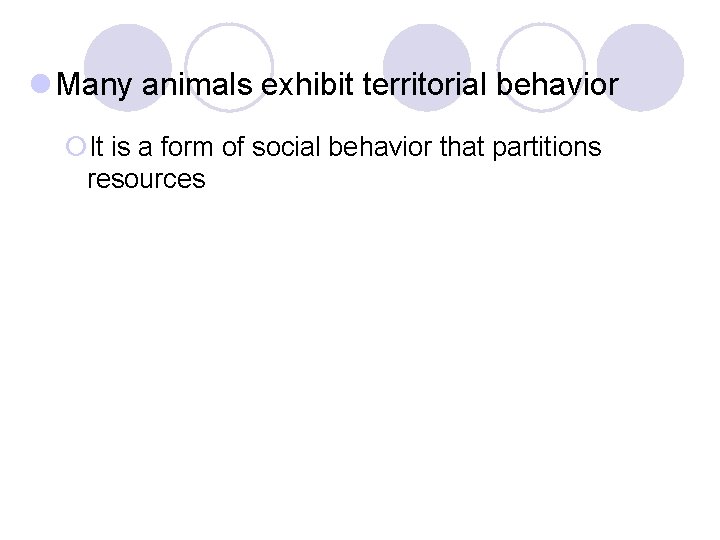
l Many animals exhibit territorial behavior ¡It is a form of social behavior that partitions resources
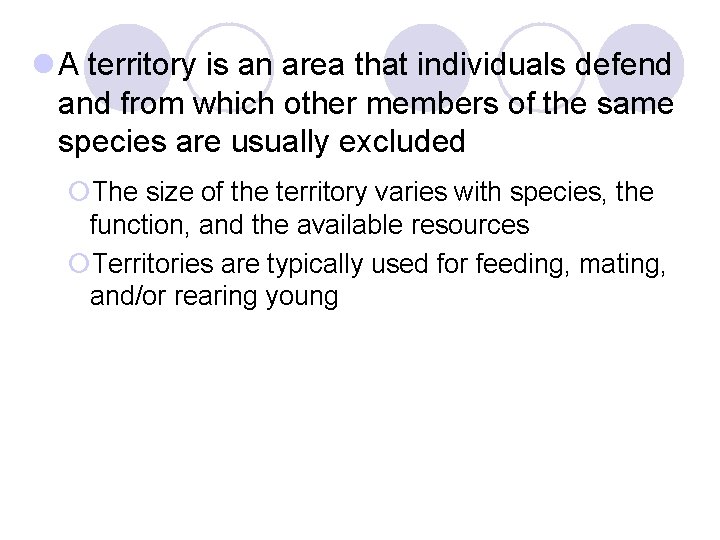
l A territory is an area that individuals defend and from which other members of the same species are usually excluded ¡The size of the territory varies with species, the function, and the available resources ¡Territories are typically used for feeding, mating, and/or rearing young
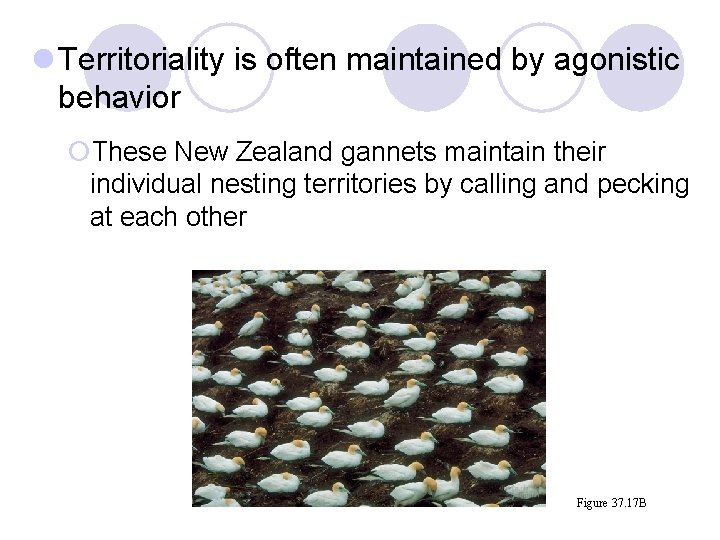
l Territoriality is often maintained by agonistic behavior ¡These New Zealand gannets maintain their individual nesting territories by calling and pecking at each other Figure 37. 17 B
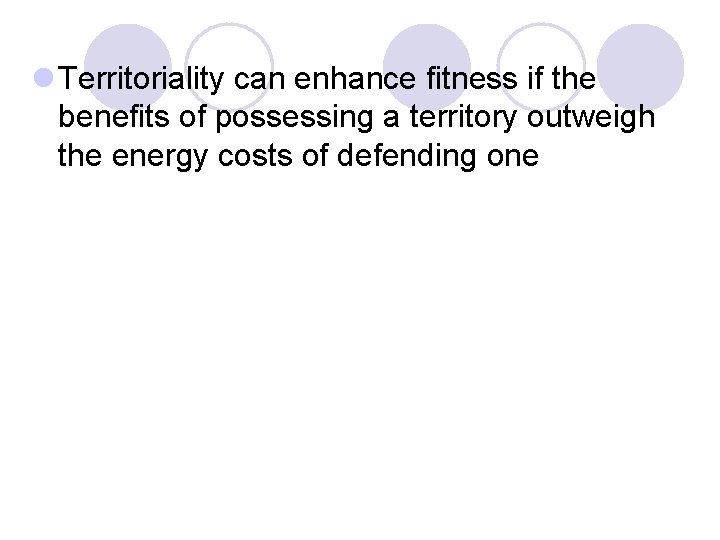
l Territoriality can enhance fitness if the benefits of possessing a territory outweigh the energy costs of defending one
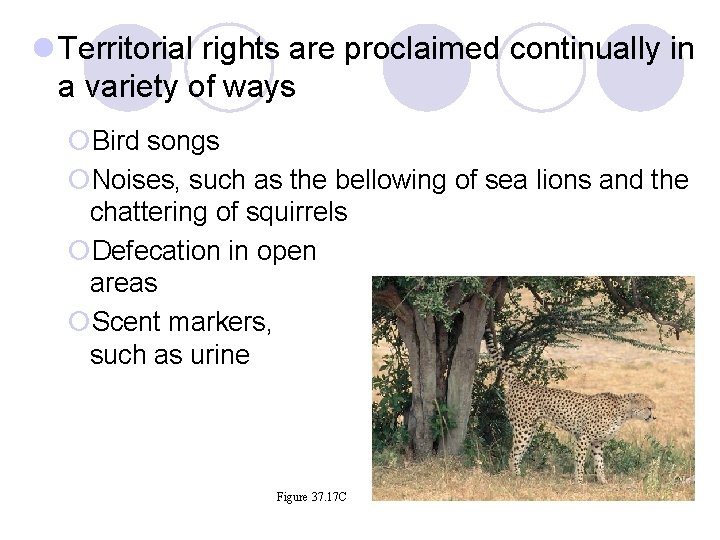
l Territorial rights are proclaimed continually in a variety of ways ¡Bird songs ¡Noises, such as the bellowing of sea lions and the chattering of squirrels ¡Defecation in open areas ¡Scent markers, such as urine Figure 37. 17 C
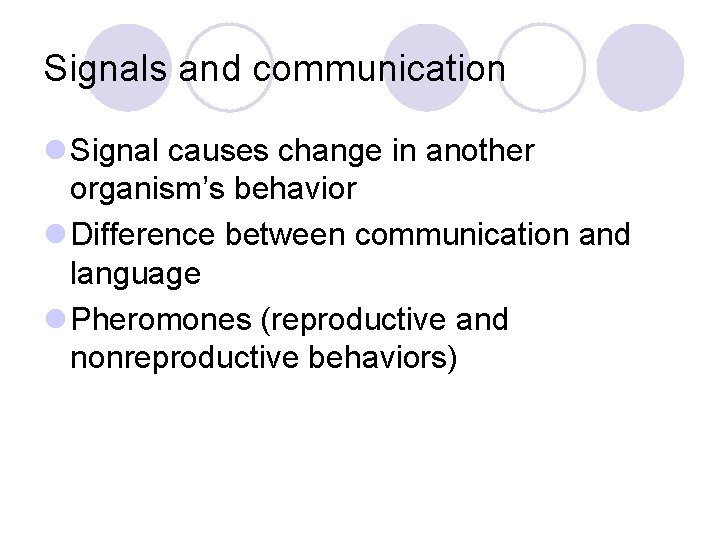
Signals and communication l Signal causes change in another organism’s behavior l Difference between communication and language l Pheromones (reproductive and nonreproductive behaviors)
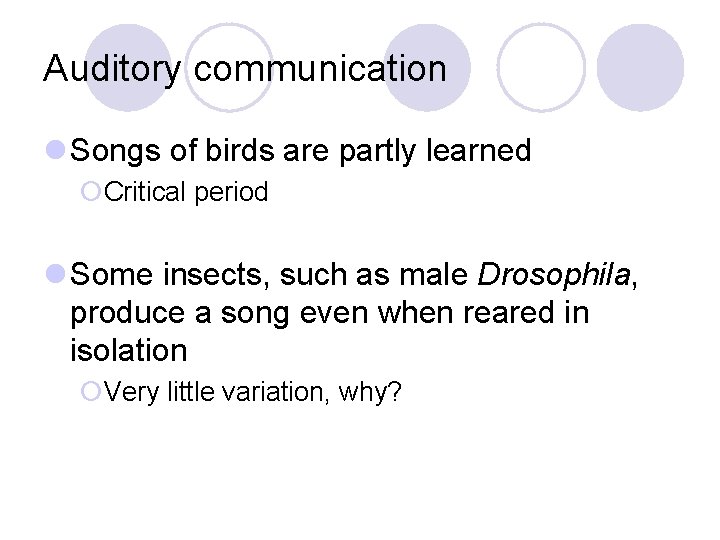
Auditory communication l Songs of birds are partly learned ¡Critical period l Some insects, such as male Drosophila, produce a song even when reared in isolation ¡Very little variation, why?
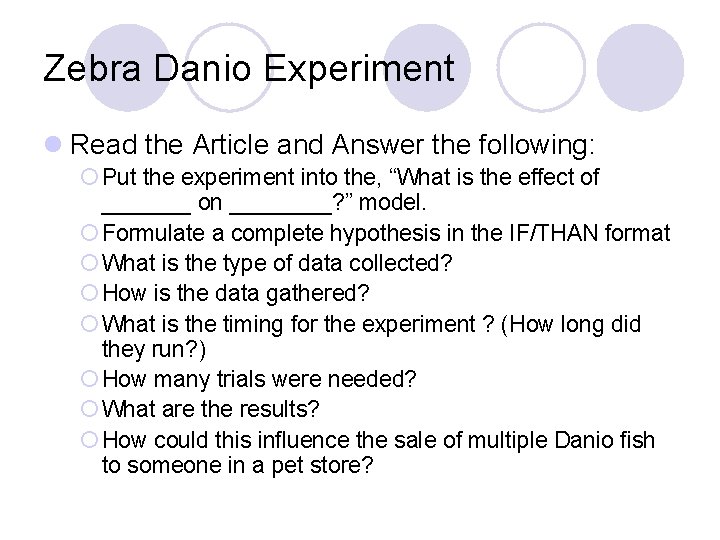
Zebra Danio Experiment l Read the Article and Answer the following: ¡ Put the experiment into the, “What is the effect of _______ on ____? ” model. ¡ Formulate a complete hypothesis in the IF/THAN format ¡ What is the type of data collected? ¡ How is the data gathered? ¡ What is the timing for the experiment ? (How long did they run? ) ¡ How many trials were needed? ¡ What are the results? ¡ How could this influence the sale of multiple Danio fish to someone in a pet store?
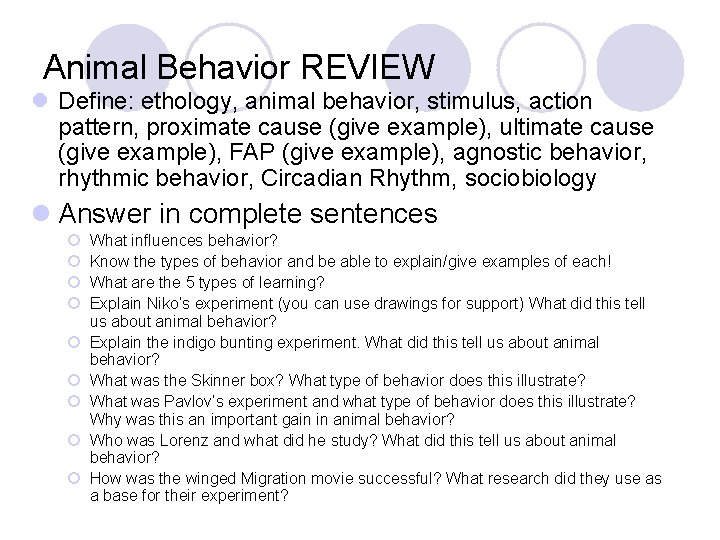
Animal Behavior REVIEW l Define: ethology, animal behavior, stimulus, action pattern, proximate cause (give example), ultimate cause (give example), FAP (give example), agnostic behavior, rhythmic behavior, Circadian Rhythm, sociobiology l Answer in complete sentences ¡ ¡ ¡ ¡ ¡ What influences behavior? Know the types of behavior and be able to explain/give examples of each! What are the 5 types of learning? Explain Niko’s experiment (you can use drawings for support) What did this tell us about animal behavior? Explain the indigo bunting experiment. What did this tell us about animal behavior? What was the Skinner box? What type of behavior does this illustrate? What was Pavlov’s experiment and what type of behavior does this illustrate? Why was this an important gain in animal behavior? Who was Lorenz and what did he study? What did this tell us about animal behavior? How was the winged Migration movie successful? What research did they use as a base for their experiment?
- Slides: 129